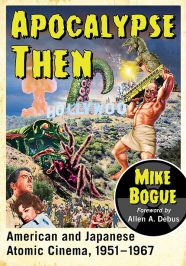„Both America and Japan produced a number of science fiction movies in the 1950s and 1960s directly or indirectly tied to the nuclear threat. … American […] films tended to suggest that it was possible to put the nuclear genie back in the bottle. However, the Japanese science fiction films of the same era were inclined to suggest that once freed, that genie could never again be imprisoned. These movies tended to end pessimistically with the nuclear threat still present; the danger was only temporarily contained.“
 What exactly was the driving power behind the many, many productions between 1951 and 1967, the years when movies about atomic monsters and radioactive mutants peaked? When the first Godzilla movie (Gojira, 1954) was presented, it was an attempt to make atomic radiation visible, according to director Ishiro Honda.
What exactly was the driving power behind the many, many productions between 1951 and 1967, the years when movies about atomic monsters and radioactive mutants peaked? When the first Godzilla movie (Gojira, 1954) was presented, it was an attempt to make atomic radiation visible, according to director Ishiro Honda.
Bogue’s strategy for finding a working theory that explains the origins and the success of those films is organized by looking at relevant American footage, then checking the respective Japanese films, and finally presenting contrasts and similarities.
His book is arranged in three major sections: Mutants (humanoid), Monsters (non-humanoid) and Mushroom Clouds (serious treatments of atomic warfare and nuclear holocaust). About 100 black-and-white film stills and movie posters illustrate Bogue’s points.
There is enough evidence to see several positions change in the development of the genre films over time: Where early in the 1950s both nations referred to giant creatures and mutants to have them represent atomic warfare and radiation, towards the mid 1960s a clear tendency to show realist settings, and sometimes original footage from atomic mushrooms prevailed. Accompanied by scenes from military war rooms and bomber planes.
But that later period also saw a lessening public interest in the dangers of atomic warfare; which was by and large an abstract idea and a hypothetical disaster. Other protest and fears concerning very real dangers and horror, like the war in Vietnam, or the violence that was directed against the civil rights movement within the US made headlines now.
Finally, in the late 1960s the classic days of the atomic monster movies were over. Only for a very brief period in the early 1980s with tensions between the Reagan Administration and the decaying Soviet Union a handful of new films (all very realistic and scientifically accurate) warning of the results of atomic warfare were made.
Nevertheless, the genre movies were not simply the ideas of directors or set decorators, but were the representations of genuine and widespread fears in the populations of both countries. Cold war threats and countless bomb shelters in the gardens of American homes were simply other (real) aspects of those anxieties. And Japan as the only nation on Earth to have experienced two atomic attacks did not have to be convinced of the dreadful effects of atomic warfare and radiation.
Mike Bogue, after taking the reader through sixteen years of busy monster and mutant design at various studios and almost ninety movies, has amassed countless details, production histories and genuine fantasies related to those films.
A treasure for any fan of the giant monster and atomic mutant films of that period.
Review by Dr. A. Ebert © 2017
Mike Bogue. Apocalypse Then: American and Japanese Atomic Cinema, 1951-1967. McFarland, 2017, 317 p.
